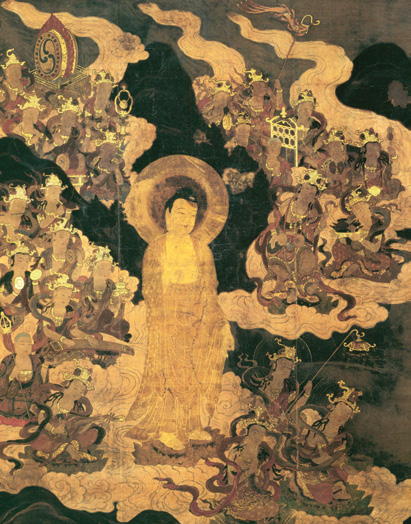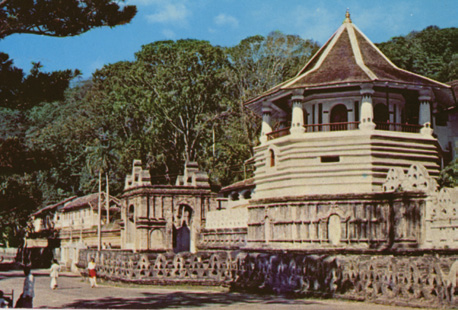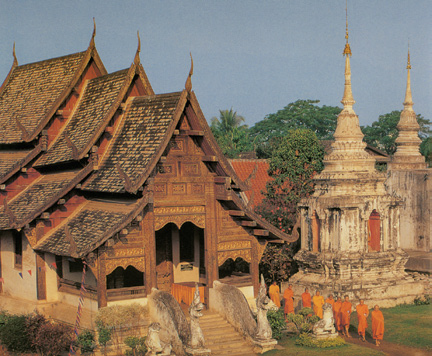An Illustrated Outline of Buddhism: The Essentials of Buddhist Spirituality (25 page)
Read An Illustrated Outline of Buddhism: The Essentials of Buddhist Spirituality Online
Authors: William Stoddart,Joseph A. Fitzgerald
Tags: #Philosophy


The Original Vow and the Pure Land School
81
Greeting picture of Amida Buddha and twenty-five bodhisattvas, Kongobu-ji, Japan
Whatever son or daughter of a family shall hear the Name of the
Blessed Amitāyus, the
Tathāgata
, and having heard it shall keep
it in their mind . . . when that son or daughter of a family comes
to die, then Amitāyus, the
Tathāgata
, will stand before them at
the hour of death, and they will depart this life with tranquil
minds; they will be reborn in Paradise.
Sukhāvatī-Vyūha-Sūtra, 10


82
An Illustrated Outline of Buddhism
Temple of the Sacred Tooth Relic of the Buddha, Kandy, Sri Lanka
If a foolish man spends the whole of his life with a wise man, he
never knows the path of wisdom as the spoon never knows the
taste of soup. If a sensitive man spends a moment with a wise
man, he soon knows the path of wisdom, as the tongue knows
the taste of soup.
Dhammapada, 64-65


83
(16) The Introduction of Buddhism
into the Theravada Countries
i. Ceylon (Sri Lanka)
Buddhism was brought to what was then called Ceylon in the third
century B.C. by Mahinda and Sanghamitta, the son and daughter of
the Indian Buddhist King Ashoka. The king of Ceylon, Devānampiya
Tissa became a Buddhist and built the Mahāvihāra (“great monas-
tery”) in his capital Anurādhapura, where a branch of the Bodhi-tree,
brought by Sanghamitta from Bodh-Gayā to Ceylon, was planted, and
is still alive today. For many centuries this monastery remained the
center of
Theravāda
Buddhism.
Mahāyāna
and Tantric schools, which
had monasteries at Abhayagiri and Jetavana, also flourished for several
centuries, but
Theravāda
prevailed, thanks in large part to the influ-
ence of the great Indian Buddhist sage Buddhaghosha who had mi-
grated to Ceylon at the beginning of the fifth century. There was a great
upsurge of
Theravāda
Buddhism at Polonnaruwa in the eleventh cen-
tury, and since the time of King Parakkambahu in the twelfth century,
Buddhism in Sri Lanka has been more or less exclusively
Theravāda
.
ii. Burma
One tradition says that Buddhism was taken from India to Burma in
the time of the Buddha by two merchants who brought with them some
of the Buddha’s hair, which is conserved to this day in the Shwedagon
Pagoda in Rangoon. Another tradition says that Buddhism spread to
Burma in the third century B.C. during the reign of the Indian King
Ashoka. For several centuries
Theravāda
and
Mahāyāna
schools co-
existed, but from the eleventh century onwards the entire country has
been
Theravāda
.
iii. Siam (Thailand)
Between the first and thirteenth centuries there were widespread In-
dian commercial links with, and colonization of, south-east Asia, in
the areas which comprise Siam, Cambodia, Laos, and Vietnam, as well
as Malaysia, Sumatra, Java, Borneo, and Bali. Hinduism flourished in
all of these countries. As far as Thailand is concerned, it is believed

84
An Illustrated Outline of Buddhism
that Buddhism of the
Theravāda
type spread there from Burma be-
tween the third and sixth centuries. The
Mahāyāna
school also flour-
ished amongst the Thais during the immediately succeeding centu-
ries. In the thirteenth century, the Thai kingdom of Sukhodaya was
founded, which became known as the “cradle of Thailandese civiliza-
tion”. Buddhism of the
Theravāda
school prevailed over Hinduism and
Mahāyāna
Buddhism, and has since then predominated in Siam.
iv. Cambodia
Both
Hīnayāna
and
Mahāyāna
Buddhism are known to have been pres-
ent in Cambodia from the third century onwards, having first entered
the country from Siam and later from Ceylon.
Mahāyāna
Buddhism
sometimes merged, and sometimes contended, with Shaivite Hindu-
ism. With the renaissance of Buddhism in Ceylon in the Polonnaru-
wa period (eleventh century), successive waves of Buddhist influence
overran the south-east Asian countries and, by the thirteenth century,
under the patronage of the Cambodian royal house,
Theravāda
Bud-
dhism made decisive gains over the other two traditions. Since that
time
Theravāda
Buddhism has been the dominant religion in Cam-
bodia.
v. Laos
The history of Buddhism in Laos closely parallels that of Cambodia.
Hinduism and the two main schools of Buddhism co-existed in the
earlier centuries. In the eleventh century, influences from Ceylon con-
tributed to the success of
Theravāda
Buddhism, and from the thir-
teenth century onwards it has been the predominant religion in Laos.
The world is afflicted with death and decay, therefore the wise do
not grieve, knowing the terms of the world.
Buddhaghosha (fifth century, A.D.)


